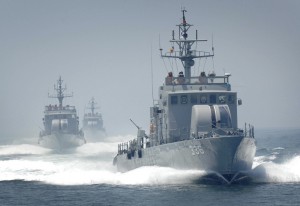
Unlike previous years, in 2014, North Korea resorted to a symmetric response to regularly held military exercises by South Korea and the U.S. in the vicinity of North Korea’s sea border, which is an important point of dispute. The crux of the matter lies in that in 1953, the land border was established by both sides, while the sea border was actually imposed on the North unilaterally, leaving most of the Yellow Sea – including several islands of strategic importance – to South Korea. North Korea does not recognize this border and advocates for it being established further south. Thus, there exists a case of disputed waters between the two countries.
This problem remains unsolved even today. In 2007, during a summit between North and South Korean leaders, Kim Jong-il and Roh Moo-hyun met to solve this problem. Creation of the equivalent of a demilitarized zone was planned, to be open to civilian boats of both countries. However, in 2008, the conservative party came to power in South Korea and these plans were abandoned. This maritime boundary has remained a source of tension. This became most clearly evident in 2010, during the incident with the Cheonan corvette and the shelling of Yeonpyeong Island.
Concerning the incident which took place at the end of March of this year, the North Koreans initially made several short-range missile launches. Then, according to the South Korean military, they fired two Rodong rockets, considered ballistic missiles. This led to a “de jure condemnation” by the UN Security Council and to the predictable reaction of North Korea.
Finally, North Korea announced an artillery firing exercise, having informed the South and “closed off” the area where the shells were to fall. Most of them fell on North Korean waters, but a number of them (data differ on the exact amount) fell on the disputed waters. President Park Geun-hye and representatives of the military leadership of South Korea repeatedly stated that, “We will make an adequate riposte in response to North Korea’s provocations.” This resulted in South Korean shelling of North Korean waters, following evacuation of the population of the islands in the area of potential conflict, in case North Korea shot back.
Based on current data, however, the situation did not escalate. All shelling fell on the water and both sides made the appropriate speeches calling for the avoidance of provocations.
Although it is unclear how the situation will develop further, South Korean mass media reported rationally, emphasizing that the South Korean side had been informed about upcoming artillery exercises. In this context, attention should be drawn to China’s prompt response. Spokesperson of the Chinese Foreign Ministry, Hong Lei, that very day called on the interested parties of the Korean Peninsula to maintain sobriety, restraint and caution – in word and in deed – in order to avoid further escalation of the conflict.
This is a good sign, since the first reports of the shelling drew an association with the above-mentioned shelling in 2010. At that time, due either to a technical error which took place during an exercise, or to a desire to feel superior, North Korean waters were fired upon. North Korea shelled South Korea’s nearest military base in response. As a result of the shelling, two soldiers and two military construction workers were killed. Although the South Korean reaction demonstrated a low level of preparedness, it shelled in response and the enemy suffered damage. This was followed by a sharp deterioration of the situation, which was halted by a meeting of the UN Security Council, convened by Russia and China.
This event was settled without bloodshed. Inter-Korean relations today are a combination of two opposing trends – statements about peace and trust are combined with conflicting actions. The situation will be described in more detail in upcoming articles, but it is worth noting now that the prudence of the military and politicians of both countries led to avoidance of an escalation of the conflict. Although South Korean exercises involve offensive actions, including the potential use of nuclear bomb delivery vehicles, and North Korea does not exclude conducting nuclear testing in response to further provocations by the South, there was no aggravation of the situation at this time – and this is a good thing.
Konstantin Asmolov, PhD, Senior Fellow at the Center for Korean Studies at the Institute for Far Eastern Studies, exclusively for the online magazine “New Eastern Outlook”.
